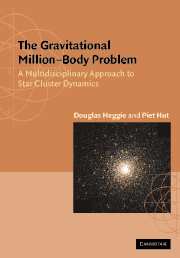Book contents
- Frontmatter
- Contents
- Preface
- PART I INTRODUCTIONS
- PART II THE CONTINUUM LIMIT: N → ∞
- PART III MEAN FIELD DYNAMICS: N = 106
- PART IV MICROPHYSICS: N = 2
- PART V GRAVOTHERMODYNAMICS: N = 106
- PART VI GRAVITATIONAL SCATTERING: N = 3
- PART VII PRIMORDIAL BINARIES: N = 4
- PART VIII POST-COLLAPSE EVOLUTION: N = 106
- PART IX STAR CLUSTER ECOLOGY
- Appendix A A Simple N-Body Integrator
- Appendix B Hints to Solution of Problems
- References
- Index
PART I - INTRODUCTIONS
Published online by Cambridge University Press: 05 June 2012
- Frontmatter
- Contents
- Preface
- PART I INTRODUCTIONS
- PART II THE CONTINUUM LIMIT: N → ∞
- PART III MEAN FIELD DYNAMICS: N = 106
- PART IV MICROPHYSICS: N = 2
- PART V GRAVOTHERMODYNAMICS: N = 106
- PART VI GRAVITATIONAL SCATTERING: N = 3
- PART VII PRIMORDIAL BINARIES: N = 4
- PART VIII POST-COLLAPSE EVOLUTION: N = 106
- PART IX STAR CLUSTER ECOLOGY
- Appendix A A Simple N-Body Integrator
- Appendix B Hints to Solution of Problems
- References
- Index
Summary
Newton's equations for the gravitational N-body problem are the starting point for all four chapters in Part I, but each time seen in a different light. To the astrophysicist (Chapter 1) they represent an accurate model for the dynamical aspects of systems of stars, which is the subject known as stellar dynamics. We distinguish this from celestial mechanics, and sketch the distinction between the two main flavours of stellar dynamics. This book is largely devoted to what is often (but maybe misleadingly) called collisional stellar dynamics. This does not refer to actual physical collisions, though these can happen, but to the dominant role of gravitational encounters of pairs of stars. In dense stellar systems their role is a major one. In collisionless stellar dynamics, by contrast, motions are dominated by the average gravitational force exerted by great numbers of stars.
We lay particular emphasis on the stellar systems known as globular star clusters. We survey the gross features of their dynamics, and also the reasons for their importance within the wider field of astrophysics. Though understanding the million-body problem is not among the most urgent problems in astrophysics, through globular clusters it has close connections with several areas which are. Another practical topic we deal with here is that of units, which may be elementary, but is one area where the numbers can easily get out of hand.
Chapter 2 looks at the N-body equations from the point of view of theoretical physicists.
- Type
- Chapter
- Information
- The Gravitational Million–Body ProblemA Multidisciplinary Approach to Star Cluster Dynamics, pp. 1 - 2Publisher: Cambridge University PressPrint publication year: 2003



